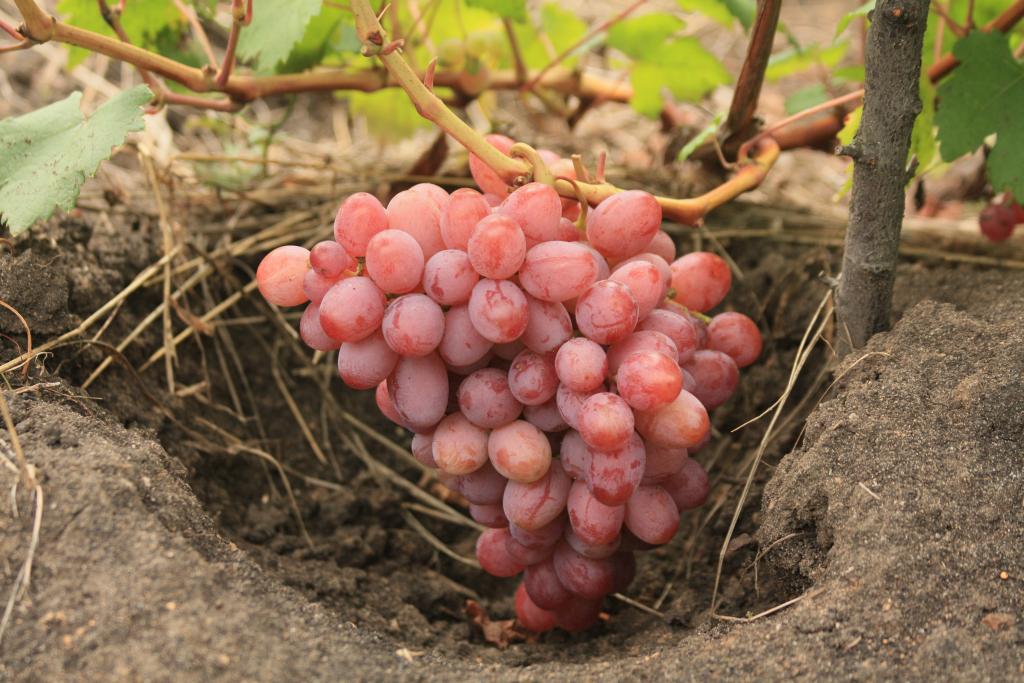
Hybrid table grapes Libya is suitable for growing on private land and on an industrial scale. Summer residents, first of all, note a pleasant sweet taste and a rich muscat aroma of berries, but this is not the only advantage of Libya.
The hybrid is relatively new, but already has a lot of fans, check out a detailed description of the variety, photos and nuances of growing.
Content
Origin history
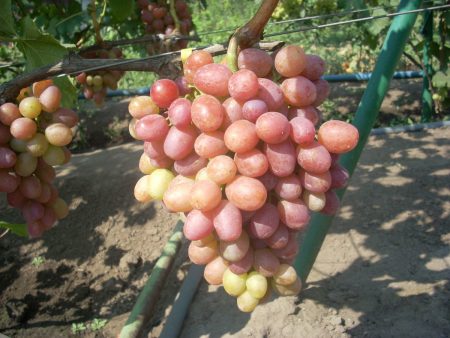
The author of the selection was an amateur winegrower from Ukraine, he bred Libya in 1999 by hybridization of the Flamingo and Arcadia varieties. In the first years after its appearance, the variety began to win honorary diplomas and awards at exhibitions and competitions.
Further work on improving and studying the properties of the hybrid was carried out jointly with the Magarach Institute of Viticulture and Winemaking. They lasted about 10 years, during which time the summer residents of Ukraine, Russia and Moldova managed to test the variety. In 2010, Libya was sent to the State Registration Service, a year later the hybrid was added to the register of varieties of Ukraine.
Description of grapes Libya
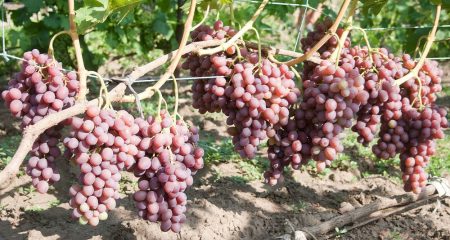
The maturity is super early, the crop is harvested 100–115 days after the appearance of the buds. The hybrid is suitable for cultivation in regions with a warm and moderately cold climate, in cities with unstable and snowless winters it requires good shelter.
Libya can withstand frosts up to 21 degrees, but only if the bush is root-bearing, otherwise frost resistance depends on the characteristics of the stock.
Characteristics of a bush, bunches and berries
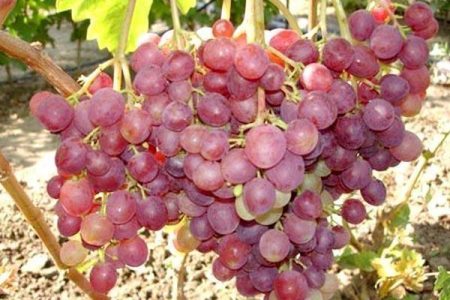
The bush is tall, powerful with fleshy stems and vines, grows very quickly. Young shoots are light green, not pubescent, the bark of annual twigs is light brown. The leaves are large, the first leaf is almost whole, the rest are of a typical, five-lobed, medium-dissected shape.
The clusters are medium-dense, branched, large, elongated in length from 25 cm or more, weighing from 500 grams to a kilogram. Brushes can be of any shape - familiar, cylindrical-conical or completely arbitrary. Small berries in clusters are rare, more often their average weight is 11–13 grams. The berries are oval, ovoid, sometimes slightly flattened, pink with a light brown tint.
The skin is soft, almost imperceptible, the bones are loose in small quantities (no more than 3). The pulp is medium-dense, juicy and sweet. A liter of Libya grape juice contains no more than 10 grams of acid and about 19% sugars. The taste, aroma and shape of the berries persist for 30 days after cutting the bunches.
Productivity, Use and Storage
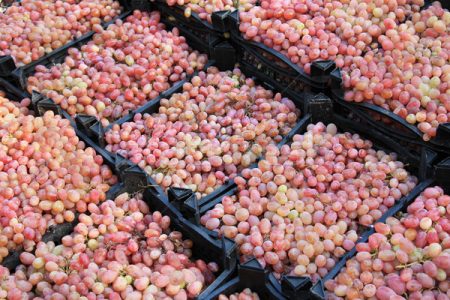
The hybrid begins to bear fruit from the third year after planting, the main purpose is the table, although some summer residents make wine out of it. Libya is suitable for the preparation of juices and compotes for the winter, fruit and berry assortment. The variety tolerates transportation well, but has a short shelf life (no more than a month in a cool basement or in the refrigerator). This does not prevent large agricultural companies from growing it on an industrial scale for processing and selling freshly harvested crops.
Productivity is consistently high, however, it is rather difficult to single out single indicators in numbers, a lot depends on the age of the bush, its branching and climatic conditions of the area.With a uniform load of branches, the berries ripen at the same time, an overloaded vine gives a yield of 20-30% less (berries of different shades of green and pink are found on one bunch).
Grapes of Libya have bisexual flowers, it bears fruit well without additional planting of pollinating varieties.
Advantages and disadvantages
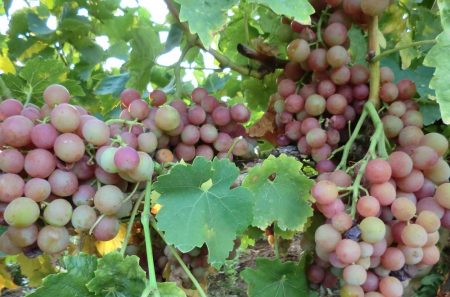
Any distributor of grape seedlings gives their products extremely positive characteristics, of course, because the main thing is to sell. But summer residents who have tried different varieties share detailed, reliable information based on their experience. After studying the comments from various forums, we highlight the following advantages of Libya:
- attractive, marketable appearance, good taste and aroma of fruits;
- simplicity in cultivation;
- transportability;
- easy reproduction;
- hybrid self-pollinated;
- high productivity from year to year.
The most significant cons, according to gardeners:
- a tendency to uneven maturation due to congestion of the hands;
- short shelf life (no more than 40 days);
- relatively low frost resistance;
- weak immunity to oidium and mildew.
All problems are solved, with proper care, cons will not appear, except for poor tolerance of frost. The bush is high, which means difficulties with wrapping up the vineyard can arise, below we will tell you how to solve them. There are very few cultivars and hybrids of culture that are completely resistant to diseases; any variety requires timely processing.
Features of planting and growing grapes Libya
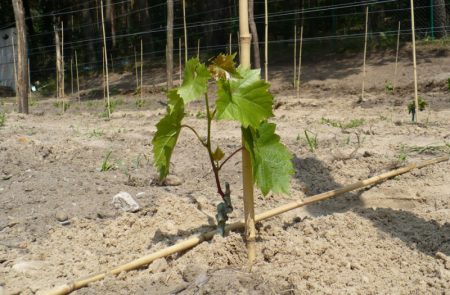
A root-growing bush will grow tall, the taste of grapes will be more saturated. The grafted plant earlier enters the fruiting stage, while the yield will be higher than from the seedling. In some cases, there is an increase in frost resistance.
When choosing and buying a seedling, inspect the root system, it should be well-branched and strong. An indicator of quality will be light brown roots, without any damage, not overdried. When the root is incised, the core is light coffee or white, and the shoot is green.
When and how to plant
From the second half of April to mid-May, annual seedlings are planted, vegetative bushes from the end of May. In autumn, planting is carried out from October until the first frost, then the bush is carefully covered. 2 days before the planned date, seedlings are prepared:
- large and small, suction roots shorten to 15 cm;
- the first day, the root is placed in ordinary water, and on the second day, growth stimulants are added to fresh water. You can take heteroauxin (2.5 grams per 5 liters of water).
In order to prevent fungi, the stem is treated in a solution of Dnock - 2.5 grams per 500 ml of water.
The grape plot is selected warm, well-lit by the sun. Dig a hole measuring 80x80x80 cm. The bottom is filled with a nutrient base: 7 buckets of humus are mixed with 2-3 buckets of earth, the layer is compacted, sprinkled with a mixture of 3 liters of wood ash and superphosphate with potassium fertilizers (300 grams each). They add garden soil, a pit no deeper than 50 cm should remain.
The bush is placed on a small hill in the middle of the pit, straighten the roots and fall asleep with ordinary soil (a hole about 25 cm should remain). The root neck is left on the surface of the earth. Experienced growers are advised to shorten the seedling to 4–5 buds. It is advisable to install the support immediately, the structure is built strong, high enough.
Watering and feeding
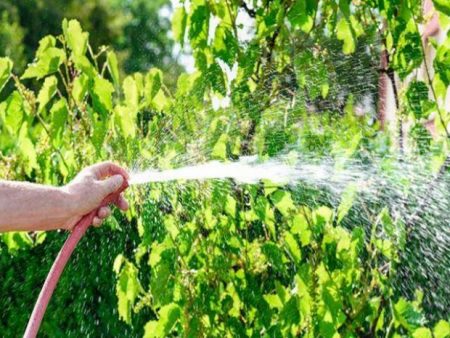
Immediately at least 2-3 buckets of water are poured under the bush, when the soil dries, water again. The next 2 waterings are carried out with an interval of 14 days (the amount of water is the same), then the trunk circle is mulched and moisturized as necessary. After each watering or rain, the soil is loosened to a depth of 5 to 10 cm. Double watering is considered optimal for the adult bush of Libya - before and immediately after flowering, additional procedures may be necessary in a long drought.
Every spring and autumn they add mulch (a layer of at least 3 cm), use rotted sawdust or humus. Before fruiting, there is no need for top dressing, then the bush is fertilized every autumn, introducing a moderate amount of organics, as well as potassium-phosphorus mixtures.
Pruning and preparing for winter
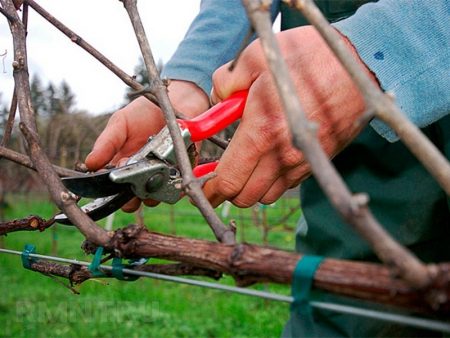
During the initial formation of the bush, leave up to 4 sleeves and shorten them by 2-6 eyes every autumn. However, short pruning is permissible only in regions with warm winters. In a temperate or cold climate, the bush is cut so that it is possible to lower the branches to the ground, cover them with soil, straw, a bag or a film.
On one bush, the total number of kidneys left should not exceed 40-50 pieces.
Immediately after planting, the bush needs to provide reliable shelter - the seedling is covered with bulk packaging, then the shelter is covered with soil so that its surface covers at least 5 cm of the earth. A beacon is installed on the knoll so that in spring, when harvesting the land, the seedling is not damaged.
The clusters of Livia grapes are mainly concentrated on the lower branches of the bush, but leaves can not be picked during the ripening period, as is recommended for other varieties. When normalizing the crop, both whole brushes and unnecessary branches in them are cut.
Diseases and Pests
Libya grapes require reliable protection against some ailments, pests, except wasps and wild birds, are not afraid of him. Prevention of any disease should be carried out in 4 stages: at the beginning and immediately after flowering, when the berries reach the size of peas and after harvesting the entire crop.
| Disease | Preventative treatments | Therapeutic spraying |
| Oidium |
Spring is colloidal sulfur (30–40 grams per 10 liters of water). Nitrafen, DNOC, Topaz, Quadris and Strobi are also suitable. Midsummer - Tiovit, Jet or Vivando. Autumn - Skor or Topaz. |
Before ripening, colloidal sulfur is used (100 grams of substance per bucket of water). Spend 2 or 3 sprayings with an interval of 20 days. If it rains within 5-8 days after treatment, the procedure is repeated. You can use drugs such as Acrobat, Skor, Vitaros, Topaz, CM. During the ripening period, use preparations with a short waiting period or dissolve 2 tablespoons of dry mustard in a bucket of water, add 40 grams of soap and treat the bushes about 3-5 times every week. |
| Mildew |
Spring - Ridomil Gold, Quadris and Strobi. Midsummer - Ditan M45, Delan. Autumn - Pergado-M, Acrobat.
|
Before the berries ripen, mildew can be controlled with copper-containing preparations, such as Abiga-peak, Bordeaux mixture, Blue vitriol, Oksikhom, Kvadris, Polykhom and others. Study the instructions, strictly follow the recommended dosages. During the ripening of berries, use organic fungicides, the best results are shown by Alirin and Gamair (mixture). 2 liters are taken per liter of water, and in advanced cases, 4 tablets. You can spray the lower side of the leaves with a solution of 5 grams of potassium permanganate in a bucket of water, and pollinate the leaves with wood ash. Processing with biological products and folk remedies is repeated until the end of the harvest with an interval of 10-15 days. |
Spraying with colloidal sulfur will be effective only at temperatures above +20 degrees. If powdery mildew is detected, the bushes do not feed anything to a full recovery.
To provide grapes with maximum protection against fungi, make sure that the crown does not thicken, it is well ventilated. Birds are scared away by various noisy devices, and wasps are trapped in sweet water, or protective gauze bags are put on bunches.
Libya is not in vain classified as the best hybrid varieties of amateur selection, because it has an attractive appearance, excellent taste, gives high yields, easy to grow and relatively hardy. Beginning gardeners, especially from the warm regions of Russia, can safely acquire a variety; it will not cause much trouble when grown.
Reviews
Maksim.The first bush of Libya planted 8 years ago, has achieved high yields since 5 years. The variety has no drawbacks, except for the uneven ripening of the berries, while the latter turn pink, the former have already ripened and cracked. Thinning brushes is a pity, but without this in any way. For the prevention of disease a week before flowering, I spray it with a mixture of Arceride (40 grams) with Tilt (6-7 grams) per 10 liters of water. When a pea-sized berry I take a mixture of Ridomil MTs (25 grams) with Tilt in the same concentration. I have a summer house in the south, so I don’t wrap up bushes for the winter.
Ellina. I live in the Irkutsk region, according to gardeners, the climatic conditions of my region are not suitable for Libya. I took a chance, planted and realized that this was all the talk of lazy gardeners! This hybrid variety needs proper care and reliable shelter. I have 2 bushes, since before wrapping up I have to cut a significant part of the buds, but the yield is always high, we have enough ourselves, and we share with the neighbors. After the onset of the first frosts, I shove the shortened branches into a bag (I leave a small hole for air to enter) and drip it with earth.

 Non-covering winter-hardy grape varieties for Moscow region
Non-covering winter-hardy grape varieties for Moscow region How to keep the vine in winter
How to keep the vine in winter When can I transfer grapes to another place in the fall
When can I transfer grapes to another place in the fall How to cover and prepare grapes for the winter in the suburbs
How to cover and prepare grapes for the winter in the suburbs